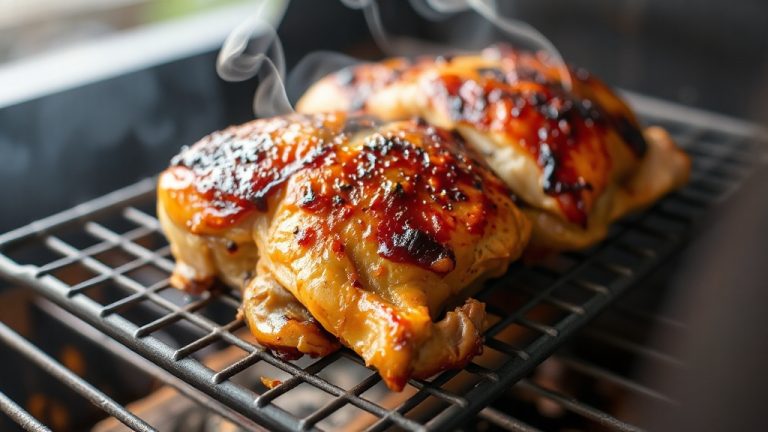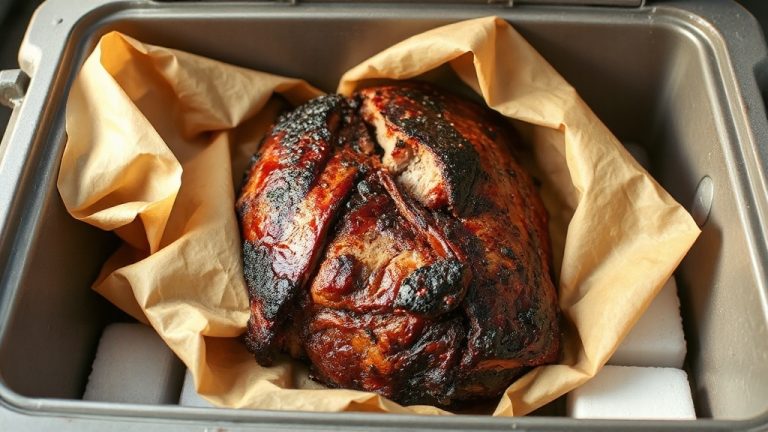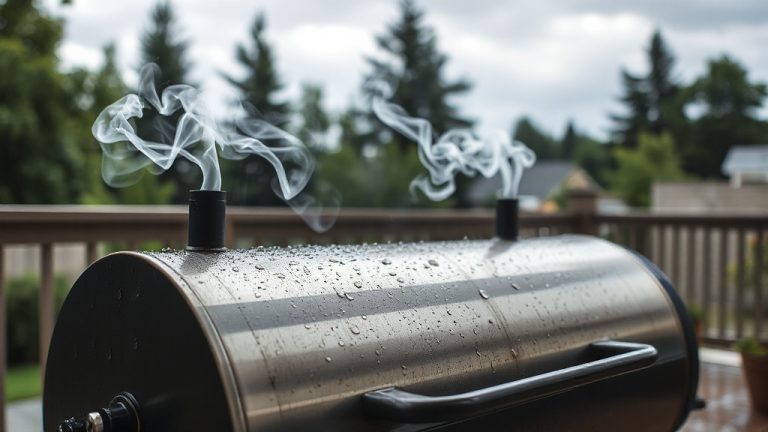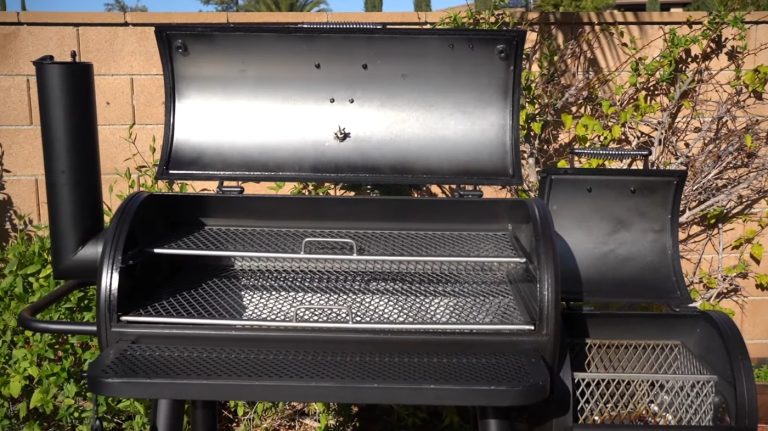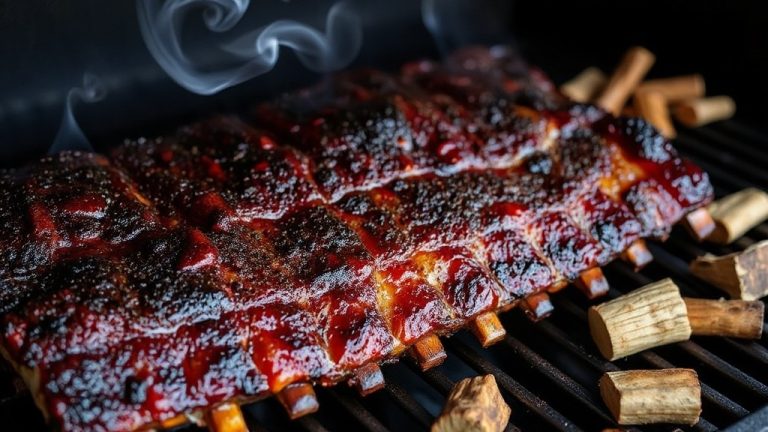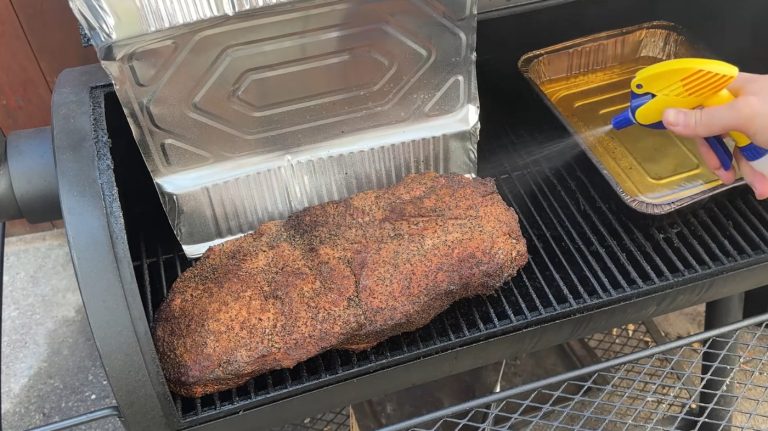Brisket Smoke Time Calculator: Timing for Pitmaster Results
You can nail your brisket’s tenderness by using a brisket smoke time calculator that factors in weight, thickness, and smoker temperature. For example, a 12-pound brisket smoked at 225°F usually takes about 12 hours, plus at least 30 minutes to rest for juicy, flavorful results.
By inputting specifics like fat content and cooking style, you’ll plan start-to-finish timing precisely, avoiding guesswork. Keep your smoker steady and learn how tweaks shape the perfect bark and smoke ring for mouthwatering brisket.
Key Takeaways
- Input brisket weight, desired serving time, meat type, fat content, and smoking temperature for accurate cook time estimates.
- Estimate about 1 to 1.5 hours per pound at 225-250°F, adjusting for thickness and smoker type variations.
- Include preparation time such as trimming, seasoning, and marinating in the total schedule.
- Account for resting time of at least 30 minutes to ensure juice retention and tenderness.
- Use the calculator to plan precise start times and manage wrapping or spritzing steps for optimal results.
Brisket Smoking Basics
Although smoking a brisket can seem intimidating at first, mastering the basics will set you up for success.
Start by trimming excess fat to guarantee even cooking and a clean presentation. You’ll want to spend about 30 minutes prepping—trimming, seasoning with salt and pepper or your favorite rub. Use a sharp knife for trimming to ensure a purposeful, clean cut.
Master the basics: trim fat, season well, and prep thoroughly for even cooking and great flavor.
Pay attention to the fat cap orientation: if you’re using indirect heat, place it fat side up to baste the meat; with direct heat, fat side down protects from scorching. Brisket sizes vary, so preparation affects your timing.
Keep your smoker between 225°F and 275°F for the best results. These fundamentals give you control and confidence, turning a formidable task into a rewarding culinary adventure. Get these right, and you’re well on your way to smoking perfection.
How Weight Influences Smoking Time?
When you’re smoking a brisket, its weight plays an essential role in determining how long it will take to cook thoroughly. Typically weighing between 10 to 16 pounds, larger briskets demand more time because heat takes longer to penetrate the center.
You can estimate about 1 to 1.5 hours per pound at 225-250°F, but remember, this varies with factors like smoker type and wrapping technique. The thicker the cut, the more patience you need to achieve that perfect tenderness.
Maintaining a consistent smoker temperature of around 240°F is crucial to ensure even cooking and optimal results temperature control. Don’t forget, resting your brisket after smoking is imperative it helps retain juices and enhances flavor.
Optimal Temperature Settings for Smoking
Mastering the ideal temperature settings is essential to unlock the full potential of your brisket’s flavor and tenderness. You’ll want to maintain your smoker between 225°F and 250°F for that perfect low and slow cook.
Hitting an internal temperature of 195°F to 205°F ensures the collagen breaks down beautifully, making your brisket juicy and tender. Keep your smoker’s temperature consistent, and add a pan of water to ensure humidity, enhancing smoke penetration and bark formation.
Additionally, resting the brisket after smoking allows the juices to redistribute, improving tenderness and flavor.
| Temperature Aspect | Ideal Range/Tip |
|---|---|
| Smoker Temp | 225°F – 250°F |
| Internal Temp Goal | 195°F – 205°F |
| Starting Temp Option | Up to 275°F, then lower |
| Humidity Control | Use water pan for moisture |
Stick to these settings, and your brisket will be a masterpiece.
Using a Brisket Smoke Time Calculator Effectively
To get the most accurate results, you need to input your brisket’s weight and desired serving time precisely—don’t guess or round too loosely.
Scheduling your start time based on these details guarantees your brisket hits the smoker at the perfect moment, so it finishes tender and juicy right when you want it.
You can also customize your plan by adding preparation steps like injections, brines, and rubs, which the calculator will incorporate into the overall schedule to enhance flavor and tenderness advanced options.
Inputting Accurate Details
Because every brisket varies, you need to input precise details into your smoke time calculator to get reliable results. Start by specifying the meat type—whole, flat, or point—and enter the exact post-trimmed weight.
Don’t overlook fat content or trimming level, as these influence cooking time and final flavor. Include the brisket’s shape and size for better accuracy. Next, set your smoking parameters like temperature and wood type.
The tool also allows you to customize options such as brining, marinating, and resting times to enhance your planning and ensure consistent results based on your schedule (customizable options).
| Detail | Why It Matters |
|---|---|
| Meat Type | Affects cooking duration |
| Weight | Directly impacts smoke time |
| Fat Content | Influences heat retention |
| Smoking Temp | Changes cooking speed |
| Wood Type | Alters smoke flavor profile |
Inputting these details carefully guarantees your brisket smokes perfectly every time.
Scheduling Start Times
When you plan your brisket smoke, starting with a precise schedule is key to serving a perfectly cooked meal on time. Use a brisket smoke time calculator by entering the meat’s weight, type, and desired finish time to get an accurate start time.
The calculator adjusts estimated time based on selected temperature for precision, helping you choose the best cooking temperature. Remember, brisket usually takes 30-60 minutes per pound at 250°F, plus an additional 2 hours for resting.
Adjust your schedule if you plan to cook low and slow at 225°F or faster at 300°F. Factor in prep time rubs, injections, tempering and monitor internal temperatures regularly to tweak timing.
Consistent smoker temperature and allowing flexibility for environmental changes ensure you meet your serving deadline without rushing. This planning precision guarantees tender, juicy brisket every time.
Factors That Affect Brisket Cooking Duration
When you’re cooking brisket, the thickness of the meat plays a huge role in how long it takes to reach perfection. Keeping your smoker temperature steady is essential fluctuations can throw off your entire cook.
Plus, the type of smoker you use affects heat distribution and efficiency, so knowing your gear inside out will help you nail your timing every time. It’s also important to minimize opening the smoker during cooking to maintain a consistent temperature environment.
Meat Thickness Impact
Although many factors influence brisket cooking time, the thickness of the meat plays a crucial role you can’t overlook. Thicker cuts need more time for heat to penetrate fully, especially if the fat layer is dense, acting as insulation.
Uniform thickness ensures even cooking, preventing underdone or overcooked portions. You must monitor internal temperature carefully, as thicker briskets take longer to reach the perfect doneness.
Holding briskets at the endpoint temperature after cooking can help maintain texture and improve yield by allowing internal temperatures to stabilize post-smoking hold. Wrapping techniques can help shorten cooking time by retaining moisture and heat.
| Thickness Aspect | Impact on Cooking Time |
|---|---|
| Thicker Cuts | Longer cooking time needed |
| Fat Layer | Acts as insulation, increasing time |
| Even Thickness | Ensures consistent cooking |
| Internal Temp Rise | Slower in thicker cuts |
| Wrapping | Can reduce overall cooking time |
Adjust your plan accordingly to master brisket perfection.
Temperature Consistency Importance
Thickness definitely shapes how long your brisket needs to cook, but keeping the temperature steady throughout the process makes or breaks your results. You want to maintain a consistent smoker temperature between 225°F and 250°F.
Fluctuations can cause uneven cooking, drying out your meat, or toughening the texture. Slower, steady heat breaks down collagen, making the brisket tender and juicy. This transformation happens because collagen converts into gelatin during slow cooking, which enhances tenderness.
Monitoring both smoker and internal meat temperatures closely helps you hit that perfect 195°F to 205°F range. Remember, high heat risks overcooking, while low heat rewards you with melt-in-your-mouth brisket.
- Maintain steady smoker temperature to avoid hot spots
- Use a reliable thermometer for accurate readings
- Avoid rapid temperature fluctuations throughout cooking
- Keep smoker humidity stable with a water pan for moisture retention
Smoker Type Influence
Since your smoker type directly shapes how heat and smoke interact with your brisket, choosing the right smoker can dramatically impact cooking duration and flavor. Offset smokers offer even heat distribution but require constant attention.
Testing shows that reverse flow smokers may cook about 10-15% faster than direct flow models, which can be significant for same-day meal planning. Reverse flow models may cook slower due to their design. Pellet smokers provide precise temperature control, ensuring consistent cooking times and steady smoke quality.
Fuel choice also matters—wood imparts robust flavor but demands more management, whereas pellets offer convenience. Insulation and chamber size influence heat retention, speeding up or slowing down your cook.
Understanding these nuances helps you adjust your timing accurately. By mastering your smoker’s strengths and quirks, you’ll nail that perfect brisket texture and taste every time, avoiding surprises in cooking duration.
Tips for Maintaining Consistent Smoker Temperature
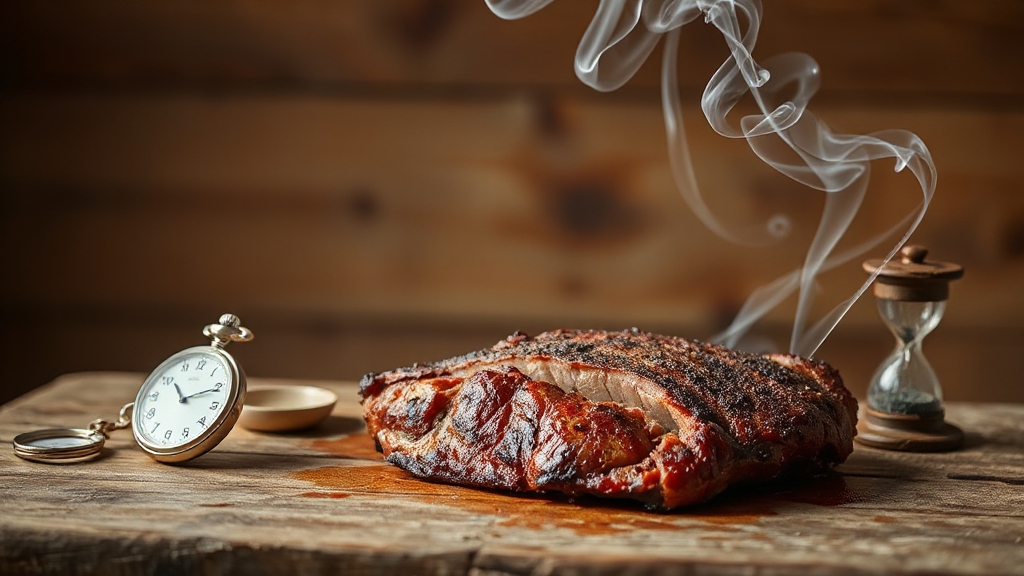
When you master vent and damper management, you gain precise control over your smoker’s temperature, which is crucial for perfect brisket.
Keep the top vent partially open to let combustion gases escape without smothering the fire, while adjusting the bottom vent to regulate oxygen flow. Proper airflow is essential to maintain consistent temperature and smoke quality throughout the cook.
Incorporate a water pan to stabilize heat and add humidity, preventing dry meat and uneven cooking. Use a well-constructed smoker with tight seals to retain heat and reduce fluctuations.
Monitor your temperature with reliable gauges and fine-tune vents or fuel in small increments to maintain steady heat.
- Keep both vents partially open at all times
- Use a water pan to stabilize temperature and add humidity
- Ensure smoker doors have good seals for heat retention
- Make gradual adjustments to vents and fuel to avoid spikes
Enhancing Flavor and Tenderness During Smoking
Although smoking a brisket demands patience and skill, you can dramatically enhance its flavor and tenderness by mastering wood selection, temperature control, and moisture management.
Choose hardwoods like oak or cherry for rich, balanced smoke, or hickory for a stronger punch. Keep your smoker steady between 225°F and 275°F to optimize smoke absorption and flavor depth.
Monitor the brisket’s internal temperature closely aim for 195°F to 205°F for perfect tenderness. Combat the stall phase by spritzing with broth or water to maintain moisture, and wrap the brisket in butcher paper or foil to lock in juices.
Finish by letting it rest in an insulated cooler, so the flavors settle and the meat stays juicy and tender turning your brisket into a smoky masterpiece.
Scheduling Your Smoking Process for Perfect Timing
Mastering the timing of your smoking process guarantees your brisket comes out tender, flavorful, and ready exactly when you want it. To schedule perfectly, start by calculating smoking time based on weight—plan about 1 hour per pound at 250°F.
Remember that larger briskets can require significantly longer cooking times due to their size and weight, so adjust your schedule accordingly. Don’t forget to factor in prep time like marinating or brining, and allow for the critical resting period after cooking.
Use a reliable meat smoking calculator to refine your schedule and monitor internal temperature consistently. Keep these essentials in mind:
- Adjust cooking time if you tweak smoker temperature.
- Include marinade or rub prep in your timeline.
- Monitor smoke levels to control flavor intensity.
- Rest brisket at least 30 minutes before serving.
With precise scheduling, you’ll serve a brisket that’s juicy, tender, and bursting with flavor right on time.
Frequently Asked Questions
Can I Use a Brisket Smoke Time Calculator for Other Meats?
You can definitely use a brisket smoke time calculator for other meats, but you’ll want to tweak the settings carefully. Different meats cook at different rates chicken needs less time than brisket, for instance and temperatures vary too.
Pay attention to weight, desired doneness, and finish temperatures. If the calculator lets you customize these factors, it becomes a versatile tool. Just input accurate details, or you risk under or overcooking your meat.
How Do Altitude Changes Affect Brisket Smoking Times?
Oh, you thought brisket cooks the same everywhere? Nope! At higher altitudes, lower atmospheric pressure slows cooking by about 20-30%. You’ll need to add time and maybe drop the temp a bit to avoid drying out your masterpiece.
Wrapping your brisket helps keep it juicy, but don’t forget to watch internal temps closely. Embrace patience and adapt—you’re crafting tender perfection, even when the mountain air tries to sabotage you!
Are There Smartphone Apps Recommended for Brisket Smoke Time Calculations?
You’ll love using smartphone apps like Smokin Log BBQ Journal to track your brisket smokes in detail, including weight, weather, and timing.
Apps like Flame Boss and Green Mountain Grill let you monitor and control temps remotely, making precise timing easier. These tools help you nail your smoke every time by factoring in real-time conditions, so you’ll get consistent, mouthwatering results without guesswork or stress.
What Is the Best Way to Calibrate My Smoker’S Temperature?
Did you know that even a 5°F error in smoker temperature can ruin your brisket’s texture? To calibrate your smoker’s temperature, start with the ice water method—immerse your probe in a 32°F ice bath, then adjust if needed.
Next, try the boiling water method at 212°F for a second check. Always let readings stabilize before tweaking. Proper calibration guarantees consistent, mouthwatering results every time you smoke.
How Does Wrapping Material Choice Impact Cooking Duration?
When you choose wrapping material, it directly affects your brisket’s cooking time. Aluminum foil traps heat and moisture tightly, speeding up cooking and preventing the stall more effectively.
Butcher paper, however, lets some steam escape, so it slows cooking slightly but keeps your bark crisper and smoke flavor richer. If you want faster results, foil’s your go-to; if you prioritize texture and flavor depth, butcher paper’s worth the extra patience.
Master Tenderness With a Brisket Smoke Time Calculator
Now that you’ve got the hang of using a brisket smoke time calculator, you’re well on your way to mastering the art of smoking. Remember, patience is your best friend—slow and steady wins the race when it comes to brisket perfection.
Keep your smoker’s temperature consistent, trust the process, and don’t rush the magic. With these tips, you’ll turn out tender, flavorful brisket that’ll have everyone coming back for seconds.

